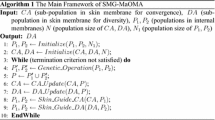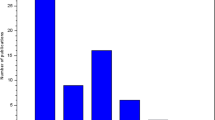Abstract
This paper presents a membrane algorithm, called MAQIS, by appropriately combining concepts and principles of membrane computing and quantum-inspired evolutionary approach. MAQIS has four distinct features from the membrane algorithms reported in the literature: initial solutions are only inside the skin membrane; different regions separated by membranes have different components of the algorithm; all the components inside membranes cooperate to produce offspring in a single evolutionary generation; communication rules are performed in a single evolutionary step. Extensive experiments conducted on knapsack problems show that MAQIS outperforms five counterpart approaches and our previous work. The effectiveness of MAQIS is also verified in the application of image processing.











Similar content being viewed by others
References
Bergeau F, Mallat S (1994) Matching pursuit of images. In: proceedings of IEEE international conference on signal processing, Piladelphia, pp 330–333
Cheng JX, Zhang GX, Zeng XX (2011) A novel membrane algorithm based on differential evolution for numerical optimization. Int J Unconv Comput 7(3):159–183
Ciobanu G, Păun Gh, Pérez-Jiménez MJ (2006) Applications of membrane computing natural computing series. Springer, Berlin
Davis G, Mallat S, Avellaneda M (1997) Adaptive greedy approximation. J Constr Approx 13(1):57–98
Gao H, Xu G, Wang ZR (2006) A novel quantum evolutionary algorithm and its application. In: proceedings of the sixth world congress on intelligent control and automation, Dalian, pp 3638–3642
Garey M, Johnson D (1979) Computers and intractability: a guide to the theory of NP-completeness. W. H. Freeman, New York
Han KH, Kim JH (2000) Genetic quantum algorithm and its application to combinatorial optimization problem. In: proceedings of the 2000 congress on evolutionary computation, vol 2. La Jolla, pp 1354–1360
Han KH, Kim JH (2002) Quantum-inspired evolutionary algorithm for a class of combinatorial optimization. IEEE Trans Evol Comput 6(6):580–593
Huang L, Wang N (2006) An optimization algorithm inspired by membrane computing, lecture notes in computer science, vol 4361. Springer, Berlin, pp 49–52
Leporati A, Pagani D (2006) A membrane algorithm for the min storage problem, lecture notes in computer science, vol 4361, Springer, Berlin, pp 443–462
Liu CX, Zhang GX, Zhang XB, Liu HW (2009) A memetic algorithm based on P systems for IIR digital filter design. In: proceeding of the 8th IEEE international symposium on dependable, autonomic and secure computing, Chengdu, pp 330–334
Mallat SG, Zhang Z (1993) Matching pursuits with time-frequency dictionaries. IEEE Trans Signal Process 41(12):3397–3415
Nishida TY (2004) An application of P system: a new algorithm for NP-complete optimization problems. In: proceedings of the 8th world multi-conference on systems, cybernetics and informatics, Orlando, pp 109–112
Nishida TY (2006) Membrane algorithms: approximate algorithms for NP-complete optimization problems, Springer, Berlin, pp 303–314. Natural Computing Series
Păun Gh (2007) Tracing some open problems in membrane computing. Roman J Inf Sci Technol 10(4):303–314
Păun Gh (2010) A quick introduction to membrane computing. J Logic Algebraic Program 79(6):291–294
Pierre V, Pascal F (2001) Efficient image representation by anisotropic refinement in matching pursuit. In: proceedings of IEEE international conference on acoustics, speech, and signal processing, Salt Lake City, pp 1757–1760
Păun Gh, Pérez-Jiménez MJ (2006) Membrane computing: brief introduction, recent results and applications. Biosyst 85(1):11–22
Păun Gh, Rozenberg G, Salomaa A (2010) Handbook of membrane computing. Oxford University Press, Oxford
Zaharie D, Ciobanu G (2006) Distributed evolutionary algorithms inspired by membranes in solving continuous optimization problems, lecture notes in computer science, vol 4361. Springer, Berlin, pp 536–553
Zhang GX (2011) Quantum-inspired evolutionary algorithms: a survey and empirical study. J Heuristics 17(3):303–351
Zhang GX, Cheng JX, Gheorghe M (2011) A membrane-inspired approximate algorithm for traveling salesman problems. Roman J Inf Sci Technol 14(1):3–19
Zhang GX, Gheorghe M, Wu CZ (2008) A quantum-inspired evolutionary algorithm based on P systems for knapsack problem. Fundam Inf 87(1):93–116
Zhang GX, Li N, Jin WD, Hu LZ (2006) Novel quantum genetic algorithm and its application. Front Electr Electron Eng China 1(1):31–36
Zhang GX, Li YQ, Gheorghe M (2010a) A multi-objective membrane algorithm for knapsack problems. In: proceedings of the fifth international conference on bio-inspired computing: theories and application, Liverpool, pp 604–609
Zhang GX, Liu CX, Gheorghe M (2010b) Diversity and convergence analysis of membrane algorithms. In: proceedings of IEEE international conference on bio-inspired computing: theories and applications, Beijing, pp 596–603
Zhang GX, Liu CX, Gheorghe M, Ipate F (2009) Solving satisfiability problems with membrane algorithms. In: proceedings of IEEE international conference on bio-inspired computing, Beijing, pp 29–36
Zhang GX, Liu CX, Rong HN (2010c) Analyzing radar emitter signals with membrane algorithms. Math Comput Model 52(11–12):1997–2010
Zhang GX, Rong HN (2007) Real-observation quantum-inspired evolutionary algorithm for a class of numerical optimization problems, lecture notes in computer science, vol 4490. Springer, Berlin, pp 989–996
Zhang H, Zhang GX, Rong HN, Cheng JX (2010d) Comparisons of quantum rotation gates in quantum-inspired evolutionary algorithms. In: proceedings of the 6th international conference on natural computation, Yantai, pp 2306–2310
Zhou F, Zhang G, Rong HN, Cheng JX, Gheorghe M, Ipate F, Lefticaru R (2010) A particle swarm optimization based systems. In: proceedings of the 6th international conference on natural computation, Yantai, pp 3003–3007
Acknowledgements
We are grateful to the anonymous reviewers for their comments that allowed us to improve this paper. The work of GZ was supported by the National Natural Science Foundation of China (61170016), the Program for New Century Excellent Talents in University (NCET-11-0715), the project-sponsored by SRF for ROCS, SEM, the Scientific and Technological Funds for Young Scientists of Sichuan (09ZQ026-040), the Fund for Candidates of Provincial Academic and Technical Leaders of Sichuan and the Fundamental Research Funds for the Central Universities (SWJTU11ZT07). The work of MG was partially supported by CNCSIS-UE-FISCSU project number PNII-IDEI 643/2008.
Author information
Authors and Affiliations
Corresponding author
Rights and permissions
About this article
Cite this article
Zhang, G., Gheorghe, M. & Li, Y. A membrane algorithm with quantum-inspired subalgorithms and its application to image processing. Nat Comput 11, 701–717 (2012). https://doi.org/10.1007/s11047-012-9320-2
Published:
Issue Date:
DOI: https://doi.org/10.1007/s11047-012-9320-2




